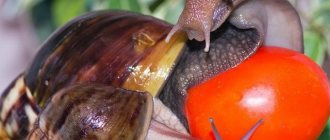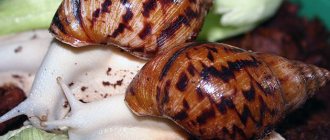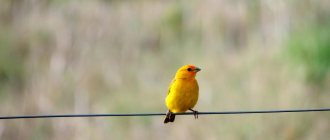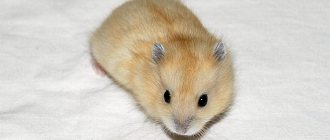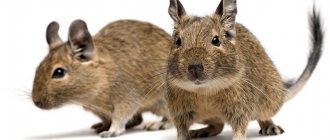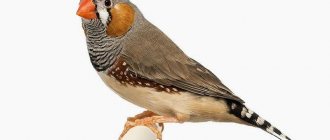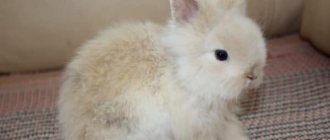Care and maintenance
African pygmy hedgehogs are not capable of living in their natural environment. Decorative animals cannot tolerate low and high temperatures. Therefore, it is necessary to maintain a certain microclimate in the room. The temperature there should be between 20-25°. If this indicator drops to 15°, the animals will hibernate.
Cage and filler
A decorative exotic living in an apartment needs a spacious cage with a solid bottom measuring at least 60 x 60 cm. It must be equipped with strong, thick bars through which the pet cannot get out.
It is recommended to cover the floor with a uniform layer 1.5-2 cm thick of birch sawdust, granulated paper or special filler. The filler needs to be changed as it gets dirty, but at least once a week.
African pygmy hedgehogs are quite shy, so the cage must have a house in which they can hide. It is also recommended to install a running wheel with a diameter of about 30 cm, a well-fixed drinking bowl, a heavy feeder and a tray.
The prickly animal is a big fan of entertainment. You can buy tunnels, balls and bells as toys for your animal.
Hygiene
In order for a decorative animal to have a neat appearance, it must be properly cared for. To eliminate parasites, heavy dirt and unpleasant odors, your pet needs to be bathed. It is recommended that the animal undergo bathing procedures no more than 1-2 times a month.
The pet is slowly immersed in a basin of warm water, carefully supported by the upper part of the body. First, thoroughly wash the paws and stomach, and only then begin to treat the back.
The pet's spines are carefully washed with a toothbrush and baby shampoo. Upon completion of the procedure, the animal is thoroughly rinsed, wrapped in a towel and waited for it to dry.
Taming
For a pygmy hedgehog to become a true friend, it needs to be educated. You can influence the character of a prickly pet if it is not yet 6 months old. Since the animal sleeps during the day, it is better to get acquainted with it in the evening. In order for an African hedgehog to get used to a human voice, you need to talk to him quietly and affectionately for 20 minutes a day.
To accustom it to the owner's smell, any item of the owner is placed in the animal's cage. And in order to establish close contact, they try to feed the pet more often from the palm.
When the animal gets a little used to its owner, you can try to lift it by its abdomen. If the pet produces thorns, it is handled with a towel or blanket. The animal must not be picked up from above. In order for the pet to calmly accept tactile contact, the palm is extended towards it from the side of the head. Then the animal will see her and calm down.
Answers to popular questions
No. When hedgehogs stop drinking their mother's milk, their digestive tract stops processing lactose. Animals can drink this drink, but they always pay for it with diarrhea.
It is not included in the diet of animals in the wild, but they quickly become accustomed to its use. Sea or river fish is boiled, steamed without salt, thoroughly cleaned of bones and given 1 tbsp. l 1 time per week. To make it easier for your pet to get used to the new product, it is mixed with pre-boiled cereals and vegetables.
Can be used to feed animals. 0.5 tsp boiled in water without salt and sugar, allowed once a week instead of millet, rice, oatmeal.
A dwarf pet should not eat this fruit, just like avocado and pineapple.
No, cookies are also contraindicated for African pygmies. They cause diarrhea in animals.
Dairy products, including cottage cheese, sour cream, and cheese, are prohibited for representatives of the hedgehog species. The high fat content in them harms the sensitive liver of pets, and lactose intolerance leads to digestive upset.
As in most semi-finished and ready-made meat products for people, sausage can contain many flavors, dyes, preservatives and other harmful additives. They have a detrimental effect on the body of a miniature animal in a short period of time.
The insects sold at bait shops are often raised in manure. They can be carriers of helminth eggs and a source of pathogenic bacteria.
For hedgehogs, feed insects should be used, which are bred specifically to enrich the diet of domestic animals.
Cockroaches, mealyworms, crickets, and grasshoppers must be purchased at pet stores. They also sell baby mice, hamsters and other treats for pets.
Proper feeding is the key to a long life for African hedgehogs. It is not difficult to organize, and the reward will be the health and grateful affection of a unique dwarf pet.
Reproduction of the African pygmy hedgehog
African pygmy hedgehogs give birth 1-2 times a year. They are mostly solitary animals, so males only meet females during the mating season. Breeding time occurs during the rainy, warm season, when there is no shortage of food, this period occurs in October and lasts until March in South Africa. The female bears the offspring for 35 days.
After birth, the membrane dries out and the spines immediately begin to grow. Weaning from milk feeding begins around the 3rd week; after 2 months, young hedgehogs leave their mother and feed on their own. At about two months of age, they begin to reproduce.
Reproduction of the African pygmy hedgehog
Breeding
African pygmy hedgehogs become sexually mature at 6 weeks of age. In order for their reproduction to be successful, adult females are not recommended to mate with very young males. And to obtain healthy and viable offspring, inbreeding should be avoided.
To mate, the animals are placed in one cage for a week. Keeping them together for longer than 7 days is not recommended.
Pregnancy in ornamental pets lasts about 36 days. During this period, the female becomes slower and more voracious. For several days after birth, the babies should not be touched, otherwise the mother will smell a foreign smell and may abandon them. For 2 weeks, the cubs feed on milk, and by 2 months they become independent.
African pygmy hedgehogs are cute ornamental animals, suitable exclusively for home keeping. Thanks to their compactness, unpretentiousness and high adaptability, they quickly moved into the category of popular pets and are able to give others a lot of positive emotions.
Feeding little hedgehogs
If you are breeding hedgehogs at home, it should be noted that in the first months of life they live with their mother and feed on her milk. In this case, you should take care of her nutritious diet so that babies receive all the nutrients through milk. It also happens that people pick up hedgehogs without a mother and do not know how to feed them on their own.
Let's consider this point in more detail.
- Babies aged 1.5 to 2 months need to be fed several times a day, optimally 2 times (morning and evening). But pregnant hedgehogs are usually fed up to 4 times a day. They are also prescribed vitamins, but it is advisable to consult a veterinarian on this matter.
- Today in big cities you can find ready-made baby formulas for small hedgehogs, which can be used to feed babies. Kitten formulas can also be used. As a last resort, they can be given goat's milk. There is also information that small hedgehogs love dog milk, but it is very difficult to get.
- Newborn hedgehogs should be fed using a pipette or small syringe. If they start spitting out formula or milk, experts recommend pouring food into them while covering the spout. The first three weeks of life, complementary feeding is carried out with 2-3 ml of milk or ready-made formula every 2-4 hours. In the fourth week, you can try placing a saucer of milk; by this time, the hedgehogs should already have learned to move and eat on their own.
- Starting from the fifth week, hedgehogs can begin to be fed with specialized dry food and try to provide them with drinking water. After 7 weeks, hedgehogs should be weaned off milk and switched to water, insects, fruits and food. They should be fed twice a day, preferably at the same time.
What to feed a hedgehog?
Africans are fed mainly cat food (not cats!), which does not contain starch or dyes.
You can also pamper your pet with bonus goodies
. Hedgehogs can be given boiled or steamed meat.
And no spices or salt! The same goes for fish. Make sure there are no bones in it.
Fruit goes great
(except dried fruits, citrus fruits, avocado and pineapple) and vegetables (except garlic and onions), eggs.
Hedgehogs will not refuse baby food either. In addition, you can try offering crickets
or grasshoppers
.
Here are the dairy products
and milk
cannot be given. It is dangerous to feed grapes and raisins, nuts and seeds.
Don't you dare
treat the animal with chocolate or fast food, and tea tree oil can cause the death of the animal, even if it smells it and does not eat it.
If you comply with all these requirements, then your African pygmy hedgehog will feel great at home.
Diet
In the twenty-first century, there is no need to think about what to feed the African hedgehog. They eat good premium cat food
Just pay attention to the composition - it should not contain starchy products, such as corn or potatoes
These animals are also contraindicated:
- Dairy products.
- Dried fruits.
- Acid-containing foods: pineapple, citrus fruits, garlic, onions, etc.
- Avocado - a hedgehog can be poisoned by this fruit, so it is better not to risk it and not include it in the diet.
- Nuts and seeds in shell. It can injure your mouth or damage your teeth.
Keeping pygmy hedgehogs is simple and enjoyable. Such an animal can bring comfort to your home and become a real favorite for children and adults.
Feeding
0 The main food of the African pygmy hedgehog is super-premium cat food. In no case should it contain starch-containing products (corn, potatoes, etc.), as well as any dyes or substitutes. The first 3, or better yet 5 components should be meat (chicken, turkey, lamb, beef, as well as fruits and vegetables). In addition to the main food, you can give additional treats. What can be given to hedgehogs additionally: Lean meat (chicken, turkey, lamb, duck, etc.) boiled or steamed without salt and spices. All types of fish are generally safe, but can affect the odor of stool and urine. Fish for hedgehog is boiled or steamed without bones, salt and spices. Fruits: apples, bananas, melon, pitted cherries, cranberries, papaya, pear, peach, apricot, pumpkin, raspberries, Jerusalem artichoke, strawberries, watermelon, blueberries, blueberries, kiwi. Vegetables: asparagus, broccoli, carrots, cucumber, green beans, peppers, peas, spinach, zucchini. Eggs, hard-boiled or scrambled without salt, sauces or spices. Quail eggs can be given raw. Baby food without dyes and preservatives. Insects: grasshoppers, crickets, grasshoppers, cockroaches. You should not give hedgehogs: Milk and any products containing milk - as we have already written, hedgehogs are lactose intolerant and eating such products can cause digestive upset. Pineapple is harmful due to the high acidity of this fruit, which can cause irritation in the mouth. Dried fruits can get stuck and stick to the larynx. Grapes are dangerous for most small pets. May cause disruption of internal organs. Raisins are just as dangerous as grapes, but in addition, they can get stuck in the teeth or stick to the roof of the mouth, which causes dental disease and inflammation in the mouth. Tea tree oil can cause death even from a very small dose of the substance, eaten or even sniffed by a hedgehog. Avocado is toxic, there are cases of poisoning with this product. Nuts and seeds can stick to the roof of your mouth, get stuck in your teeth, and damage your eyes as your hedgehog tries to remove them from the shell. Any citrus fruits. Onion garlic. Fast food, chips, etc. Chocolate. Products containing dyes, food additives and chemical preservatives are harmful to hedgehogs for the same reason as they are harmful to humans. Only on pygmy hedgehogs do all the consequences of eating such food appear more acutely and quickly than on humans.
Description
Domestic hedgehogs are not fundamentally different from forest hedgehogs. They have the same soft body and neat short legs. The hedgehog has four toes on its hind paws, and five on its front paws.
The muzzle of the African hedgehog is also elongated, the areas of the cheeks and eyebrows are covered with pleasant, light-to-the-touch fur. This animal's nose is constantly sniffing out tasty treats, so it twitches non-stop! The ears are neatly oval shaped and pressed to the head.
The size of the animal is small. Weight ranges from 350 to 500 grams, and body length is only 15-20 centimeters. The African hedgehog is not picky about its care, so it will be an excellent gift for a child.
The hedgehog's needles are located on the top of the head, on the sides and on the back; they are small, 2-3 centimeters each. The color can be any:
- Black, or as many people like – “salt and pepper”. This is the color of the hedgehog's muzzle, ears and needles.
- Gray color. The needles can be either gray or brown, but the muzzle and ears will still be black.
- Chocolate is the color of the face and needles, and the ears will be gray.
- Brown individuals are extremely beautiful. The needles are the color of oak bark, the mask on the face is lighter, the ears are pink, and the eyes are framed by a blue border!
- “Cinnamon” is also a very beautiful color. The needles are light brown, the ears are pink, there is practically no mask, and the eyes are dark burgundy.
- “Tsinakot” is one of the exotic colors, where light beige and pale brown colors are beautifully combined.
- “Champagne” is a light beige color on which scarlet eyes look great.
- “Pinto” - in this version, some of the needles in the coat have no pigment and remain snow-white.
- The albino African hedgehog is very, very rare. These are individuals that are deprived of color pigment in their color from birth, but have red eyes.
In the natural habitat, all the listed color variations do not exist! The African domestic hedgehog also differs in its character from forest dwellers.
Walking outside
Like all living creatures, African hedgehogs, whose maintenance is not at all burdensome for its owner, also need fresh air. If it’s a warm, fine day outside, but without stuffiness and exhausting heat, you can take a walk with the animal.
It should be remembered that they are very nimble and can run out onto the grass and eat an earthworm or some insect. This should not be allowed under any circumstances. The fact is that after eating a worm, hedgehogs can get capillariasis. Street insects only cause harm. You should give your pet only those that have been grown artificially. In addition, various microbes live in the grass, from which you should protect your pet.
Feeding
You shouldn’t think too much about what the African hedgehog eats. Premium cat food is perfect for him. It is natural and does not contain any flavors or other harmful additives. It is also necessary to ensure that the food does not contain starchy ingredients, such as corn or potatoes.
Since cat food is largely multi-component, it is good if it has a meat base. It could be chicken, beef or turkey. But don't forget about fruits and vegetables.
In addition to meat and plant products, sometimes you need to pamper hedgehogs with such unusual gifts as crickets, grasshoppers and zoophobes.
“Specific feature” of this breed:
You need to know in advance that this breed has a specific feature - hedgehogs coat themselves with saliva.
Urine, and not only your own, can be used for the same purposes.
Animals do this for certain reasons - they feel fear and try to hide under a different smell, or they feel unwell and try to “lick their wounds.” In any case, be prepared for the unexpected when picking up an African
In any case, be prepared for the unexpected when picking up an African.
The very process of throwing saliva can scare you - you need to get used to it, because the sight is not a pleasant one.
Injuries and illnesses of hedgehogs
In addition, these hedgehogs are record holders for paw injuries. Hairs or threads are often wrapped around them, which they find in the corners, and this leads to tumors.
And these are not the only possible health problems: African pygmy white-bellied hedgehogs are highly susceptible to parasite infections from cats, dogs or rodents.
There are major problems with teeth, vision, and stomach, so take careful care and monitor your diet.
Ordinary African hedgehogs (living in the wild) have stronger immunity and live quite happily in the wild, while dwarf hedgehogs simply cannot survive there (thanks to the domestication of animals by humans for this).
There are 4 species of African hedgehogs: Somali, Algerian, South African and white-bellied.
African hedgehog at home
This animal, regardless of its variety, is almost as if created to be a pet. Moreover, these animals have been kept in houses and apartments for a very long time; hedgehogs were kept back in the 19th century, so any description of them will necessarily be mostly devoted to the behavior of animals in the house, and not in nature.
The only difficulty that inexperienced owners may encounter is the hedgehog’s gluttony, which leads to excess weight, difficulty moving, and earlier aging and death.
Otherwise, the hedgehog is simply an ideal pet, of course, if you buy exactly the species that is as close as possible to its own established way of life, or buy a pygmy hedgehog that easily adapts to everything in the world.
The African hedgehog may sleep during the day, but when you come, it becomes a companion
The price of African hedgehogs depends on many things, including their variety. The cheapest are the mestizos that were born due to carelessness or due to the experiments of the owners - from 2 to 4 thousand rubles.
The cost of a white-bellied hedgehog averages 6-7 thousand rubles, and a dwarf hedgehog costs about 12 thousand rubles. Algerians and Somalis will cost less - from 4,000 to 5,000. These are average prices in pet stores, however, among private advertisements it is quite possible to find a hedgehog several times cheaper or even for free.
How to name a pet
When choosing a name, you can only be limited by your own imagination.
You can call a hedgehog by any nickname that suits your liking. For example, start from the thorns of a pet (Cactus, Kolyuchkin, Needle, etc.) or transform the word hedgehog (Ezhana, Ezhinka, Hedgehog, etc.).
You can name a hedgehog based on its external features (White, Snowflake, Coal, etc.). In other words, you can come up with a huge number of nicknames for a prickly pet. Just use your imagination.
The African pygmy hedgehog is an ornamental animal that was bred specifically for indoor living. The hedgehog is quite unpretentious in food, has a small size, and requires a minimum amount of time. In addition to these positive aspects, the pet is highly trainable and can become a loyal friend to its owner.
join the discussion
In recent years, it has become especially popular to keep ornamental African hedgehogs that do not live in the wild at home. It is for this reason that they should not be released for free range. This breed of hedgehogs was obtained through the selection of several breeds, as a result of which the mammals turned out to be very hardy and at the same time adapted for life in an apartment or private house. Next, we will take a closer look at the description of such animals, learn everything about their life expectancy and maintenance, and also get acquainted with the features of caring for them and feeding rules.
Population and species status
Photo: Domestic pygmy hedgehog
Common hedgehogs can be found almost everywhere. They are found in Europe and on the shores of Scandinavia, in Russia and in hot African deserts, in hot tropical steppes and even in the East. Hybrid breeds are mostly found only in captivity. The lifespan of hedgehogs depends not only on genetic characteristics, but on living conditions, nutrition and care. In captivity, with good care and maintenance, as well as a balanced diet, individuals can live for about 7-8 years.
Dwarf individuals are found only in artificial environments. In terms of care, they are practically no different from ordinary hedgehogs, they eat very well, make noise at night and sleep during the day. But, unlike other pets, hedgehogs do not chew furniture, you do not need to walk with them and there is no need for bathing. However, when attempting contact, the child may be injured by the sharp teeth of an animal that is simply afraid and trying to defend itself. The African pygmy hedgehog makes a good pet. But you need to be careful not to let your child play with the animal on his own.
Reproduction
In the wild, when a male and a female meet, the former will court their partner for many hours, will snort and chirp, even growl, showing a warlike character. When the hedgehog is ready to mate, she will lower her quills and extend her hind legs.
At the moment of coitus, the male leaves a “wax” plug in the female’s vagina, which prevents repeated sexual intercourse and insemination by other hedgehogs. After copulation, the partners separate, and the mother carries and cares for the brood on her own. It can produce up to 2 litters per year.
It is easy to determine the sex of a hedgehog - males have a penis and foreskin located in the middle of the abdomen, females have a vagina, located near the anus.
The mating and sexual reproduction season is from October to March. Girls become sexually mature at the age of one year; pregnancy lasts about 34-39 days.
In one litter, the female gives birth to from 1 to 7 cubs, on average 3-4.
Newborn babies weigh about 10 grams. A few hours after birth, soft, white spines grow, dark ones grow on days 2-3, eyes open at 2-3 weeks, and already at 4-5 weeks they can leave the nest on their own.
At the age of 1.5 months, babies become independent.
Description of hedgehogs
The hedgehog family includes 2 subfamilies. These are real and gymnur or rat hedgehogs. Gymnurs have a body covered with hard hair, a long tail, and an elongated muzzle.
They look more like a big rat. Real hedgehogs look a little different:
- body size 10-44 cm. Animals with a body length of up to 15-25 cm are kept at home. Weight from 200 g. Forest inhabitants can weigh up to 1.5 kg;
- the back, sides and head are covered with a shell of needles. The muzzle, limbs and belly are distinguished by soft wool. Adult hedgehogs have up to 6 thousand spines on their bodies. Their length is 3 cm, the surface is smooth. The needles have gray and brown bands, which alternate with light stripes. Powerful muscles are attached to the shell, which allow animals to quickly gather into a ball or straighten their body;
- the length of the tail is 1-3 cm. It is often hidden under the needles;
- The animals have an elongated muzzle. In healthy individuals, the nose is always wet;
- the teeth are sharp and small. The front incisors are especially developed;
- Animals have 4 five-fingered limbs. The front ones are shorter than the rear ones. The fingers have long and sharp claws. Being in their natural environment, they constantly wear out. The claws of a domestic hedgehog are cut off;
- hedgehogs are nocturnal inhabitants, so their organs of vision are poorly developed, but their organs of hearing and smell are well developed;
- In summer, animals are very active. In late autumn they hibernate. At the same time, their pulse slows down to 20 beats per minute, and their breathing rate - 1 time per minute. They remain in this state until spring. They emerge from their burrows when the air temperature rises to 15 C. Some types of hedgehogs that are kept at home sleep only 2-3 days;
- animals are predatory. They feed not only on insects, but also on small vertebrates, lizards, and frogs. They may eat chicks or bird eggs. They replenish the body’s vitamin reserves with berries and grass. Hedgehogs quickly adapt to new conditions and get used to new food.
- Animals have poorly developed sweat and sebaceous glands. A domestic hedgehog does not emit any foreign odor. Does not cause allergies.
Representatives of hedgehogs are solitary. In nature, they occupy the burrows of other animals or hide under the roots of trees. They make a hole out of dry leaves, grass and soft moss.
They try to stay in their shelter all day long; at night they crawl out of their holes in search of food. Individuals determine their territory, in which they hunt, and jealously guard it.
Hedgehogs mature at 12 months. During the season, the female brings 1-2 litters. Pregnancy lasts 49 days. Each can have 2-5 cubs.
They are born blind with soft spines. The real shell is formed already on the 15th day.
The cubs feed on milk. From the age of one month they begin to emerge from the hole. The mother teaches them to get food.
Diseases
Hedgehogs are prone to many diseases, including cancer and Wobbly Hedgehog Syndrome (WHS). Some symptoms of WHS resemble those of multiple sclerosis in humans, so the condition in animals can be compared to what patients with multiple sclerosis experience. These include the inability to move normally, tremors of the limbs, staggering when walking, etc. A possible cause of WHS is a genetic defect that allows the virus to attack the hedgehog’s nervous system.
The nose can exhibit a variety of alarming symptoms, especially respiratory illnesses such as pneumonia. In many cases, the form of pneumonia that affects hedgehogs is bacterial in nature. When acted quickly, antibiotics can have a very positive effect. Observable signs include blisters, excessive mucus production, or persistent sneezing.
Choosing a house
Before buying an animal, you need to take care of where it will live. A rabbit cage, as well as a glass or plastic terrarium, can serve as a house. The size of their bottom must be no less than 60 X 60 cm. The house must be closed from above, otherwise the hedgehog will run away. If you want it to be open, then the walls of the future home should have a fairly slippery coating, and their height should be more than 30 cm.
It is necessary that the bottom of the house is solid. A floor made of twigs is strictly prohibited, as the hedgehog’s small paws will always get caught in them. The distance between the rods should be small. Given the size of the animal as a child, it could easily escape or get stuck between them.
Features of character and lifestyle
Photo: African pygmy hedgehog
The African pygmy hedgehog is highly active and loud. He can snort cheerfully and growl if a stranger suddenly encroaches on his separate territory. When a hedgehog is injured and in severe pain, it can squeal very loudly, notifying the entire neighborhood about its problem. An interesting fact is that during a fierce battle with an enemy, a hedgehog chirps like a big bird, confusing its enemy and terrifying him with incomprehensible sounds.
Hedgehogs are very active at night, when they hunt for small insects or rodents. The animal lives in a hole dug between boulders or under a heap of old branches. May take over someone else's burrow left by a rodent or other animal. In the summer, hedgehogs hibernate, which lasts until autumn.
At home, pygmy hedgehogs can be kept in cages or aquariums, or you can let them walk around the apartment. But you definitely need to create an artificial burrow from cotton wool or twigs, straw or cardboard. In such a shelter the hedgehog will feel warm and safe.
The animal is distinguished by the following features:
- very agile;
- runs fast;
- climbs well through thickets of bushes and piles of boulders;
- has very acute hearing;
- good sense of smell.
All hedgehogs are slightly blind; they see very poorly during the day. Their night vision is well developed. Hedgehogs are land animals, but they swim well and navigate well under water.
In their natural habitat, each individual has its own territory, which can reach up to 500 meters and is carefully protected from the encroachments of possible rivals.
Features of keeping a new pet in an apartment:
To keep such a white-bellied hedgehog in an apartment, you need to know some nuances, namely:
First, when you bring your pet home, give him a day to adapt. Don't swoop in with the whole family, don't look at him or touch him - he should get comfortable and get used to it, without stress.
Cell:
The cage must be suitable; it is better not to use aquariums, as it will be easy for your pet to escape.
It is better to opt for a high cage with a bottom size of at least 60x60 centimeters. Photo of African white-bellied hedgehog:
Please note: the distance between the bars should be small, otherwise miniature Africans will squeeze between them and go on a journey around the apartment. Even worse, they can get stuck and damage vital organs.
Even worse, they can get stuck and damage vital organs.
Temperature and lighting:
The cage should be placed in a warm and well-lit place. At the same time, avoid direct sunlight and especially drafts.
The most comfortable temperature varies between 20-26 degrees.
Filler:
When choosing a filler, it is best to opt for aspen or birch sawdust.
But cedar sawdust is strictly prohibited - they are toxic to hedgehogs, like all sawdust containing essential oils.
For adults, corn on the cob is also suitable. Another option is paper granules.
In addition, fleece or flannel is often used for these purposes - they absorb well and prevent hedgehogs from getting their paws tangled.
And the main advantage of such materials is their color - if the material is light, then you can easily see blood or unhealthy color of feces on it, which is a signal about the health of the animal.
Toys, feeders and “real estate”:
You also need to set up a house in the cage. Chinchilla houses or a small sleeping bag are suitable for this - hedgehogs really like them.
Don't forget the wheel
Please note that its diameter must be at least 28 centimeters
Also pamper the animal with toys - he should like balls with bells.
Since the hedgehog likes to turn everything over and scatter it, you need to choose a heavy bowl for food.
Ceramic cups for rodents are perfect. Just try to keep them no more than 5 cm in height, otherwise your pet will never get to the food.
But the drinker should be a nipple one, since hedgehogs tend to throw sawdust into the water, which is why they then cannot drink.
Existence in nature
The ancestor of the beloved domestic hedgehog was a dwarf African species. Mostly the ancestors of the artificially bred hedgehog live in Ethiopia, Tanzania, Somalia, and Senegal. Wild hedgehogs are true predators, while domesticated ones are endowed with an incredibly docile, gentle disposition.
In nature, these animals avoid wooded areas, choosing rocky places in the bushes, deserts and tropical savannas to live. As everyone knows, a lot of poisonous snakes also live in such areas. But they are not scary for hedgehogs, since they are immune to snake venom. In addition, African hedgehogs do not react to potassium cyanide, arsenic and many other poisons.
Nature has given hedgehogs real superpowers: a keen sense of smell and hearing, nimble paws. Thanks to this, predators can smell prey even if it is five meters underground.
A hedgehog should eat about a third of its weight per day. Preference is given to night hunting, when you can quietly steal a bird's egg, drag away a snail, a small snake (even a poisonous one), or a scorpion. But the diet also includes plant foods - roots, berries and mushrooms, various herbs.
During the day, the animal prefers to be out of sight, hiding in holes, piles of leaves and roots. These are real dormouse; they hibernate at the beginning of summer and awaken in the fall.
Since October, hedgehogs have been looking for a mate. They can not only snort to express their feelings, but also perform real mating dances!
Feeding
You shouldn’t think too much about what the African hedgehog eats. Premium cat food is perfect for him. It is natural and does not contain any flavors or other harmful additives. It is also necessary to ensure that the food does not contain starchy ingredients, such as corn or potatoes.
Since cat food is largely multi-component, it is good if it has a meat base. It could be chicken, beef or turkey. But don't forget about fruits and vegetables.
In addition to meat and plant products, sometimes you need to pamper hedgehogs with such unusual gifts as crickets, grasshoppers and zoophobes.
What color are pygmy hedgehogs?
The color of dwarf African hedgehogs is different and very diverse. In pet stores and hedgehog breeders (yes, there are such things too) you can find the following “war paints”:
- Hedgehogs with a black or salt-and-pepper color have almost all of their spines dark, as are their ears and mask;
- Gray urchins have either dark gray or dark brown spines. The ears are dark gray and the mask is black;
- The “chocolate” color suggests dark brown needles, light gray ears and a light brown mask;
- Brown urchins have oak bark colored needles, pink ears and a light brown mask. Representatives of this color do not just have black eyes - they have a blue edge;
- With the “cinnamon” color, hedgehogs have light brown spines, pink ears and dark ruby eyes. The mask is practically invisible;
- With the “cynacott” color, fragmentary coloring of the needles is observed: some are light brown, some are pale beige. The ears are usually pink, the mask is invisible;
- “Champagne” hedgehogs have pale beige needles and light ears, and scarlet eyes;
- The “pinto” color is also found - in these hedgehogs, some of the needles are devoid of pigment (they are partially albino).
And the last color variety is a complete albino. These hedgehogs have snow-white needles, scarlet eyes and no mask. Such white hedgehogs are quite rare.



